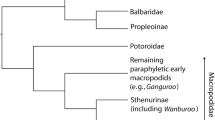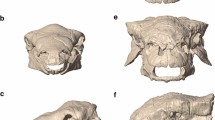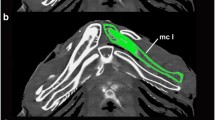Abstract
Within Anseriformes, waterfowl (ducks, geese, and swans) exhibit three specialized feeding modes that are distinctive among Aves: filter-feeding with fine and dense keratinous lamellae on a flat, mediolaterally expanded bill; cropping or grazing vegetation with large and robust lamellae with a dorsoventrally expanded bill; and sharp lamellae associated with a narrow bill used in acquiring mixed invertebrates and fish underwater mainly by grasping. Here we assess morphometric variation in cranial and hyolingual structures as well as hyolingual myology in a diverse sample of Anatidae to explore the relationship of tongue variation and feeding mode. Phylogenetically informed principal component analysis (phyl.PCA) of cranial-lingual measurements for 67 extant and two extinct anatids recovers grazers and filter-feeding taxa in largely distinct areas of morphospace, while underwater graspers and other mixed feeders show less distinct clustering. The relationship between morphometric differences in skeletal features and muscular variation was further explored through a reassessment of hyolingual musculature enabled by contrast-enhanced X-ray computed tomography (CT) imagery acquired from three exemplar species (Branta canadensis, Chen caerulescens, and Aythya americana) with distinctive ecologies and morphologies of the bony hyoid. Data for these duck and geese exemplars reveal further significant, and previously unstudied, morphological differences between filter-feeding and grazing species. Grazers have a larger hyolingual apparatus with highly-developed extrinsic hyoid muscles; while filter-feeding species are characterized by relatively more diminutive extrinsic hyoid muscles and larger intrinsic hyoid muscles. The feeding modes of two extinct taxa (i.e., Presbyornis and Thambetochen) were also estimated from morphometric data. The results indicate a derived terrestrial browsing or grazing ecology for Thambetochen but do not unequivocally support a specialized filter-feeding ecology for Presbyornis, which is recovered with mixed feeders including swans. The combination of detailed, CT-mediated acquisition of fine muscular anatomy with morphometric approaches shows promise for illuminating form–function relationships in extant taxa more generally.









Similar content being viewed by others
References
Baldassarre, G. A., Bolen, E. G., & Sayre, T. R. (2006). Waterfowl ecology and management. Malabar, FL: Krieger.
Batt, B. D. J., Afton, A. D., Anderson, M. G., Ankney, C. D., Johnson, D. H., Kadlec, J. A., et al. (1992). Ecology and management of breeding waterfowl. Minneapolis and London: University of Minnesota Press.
Blackburn, D. C., Siler, C. D., Diesmos, A. C., McGuire, J. A., Cannatella, D. C., & Brown, R. M. (2013). An adaptive radiation of frogs in a Southeast Asian island archipelago. Evolution, 67, 2631–2646.
Carboneras, C. (1992). Anseriformes. In J. Del Hoyo, A. Elliott, & J. Sargatal (Eds.), Handbook of the birds of the world (1st ed., Vol. 1, pp. 527–628). Barcelona: Lynx Edicions.
Diogo, R. (2004). Muscles versus bones: Catfishes as a case study for a discussion on the relative contribution of myological and osteological features in phylogenetic reconstructions. Animal Biology-Leiden, 54, 373–392.
Donne-Goussé, C., Laudet, V., & Hänni, C. (2002). A molecular phylogeny of anseriformes based on mitochondrial DNA analysis. Molecular Phylogenetics and Evolution, 23, 339–356.
Dunning, J. C. (2008). CRC handbook of avian body masses (2nd ed.). Boca Raton: CRC Press.
Durant, D. (2013). The digestion of fibre in herbivorous Anatidae: A review. Wildfowl, 54, 7–24.
Dyreson, E., & Maddison, W. P. (2003). Rhetenor package for morphometrics for the Mesquite system. version 1.0. http://mesquiteproject.org.
Erickson, P. G. P. (1997). Systematic relationships of the palaeogene family Presbyornithidae (Aves: Anseriformes). Zoological Journal of the Linnean Society, 121, 429–483.
Feduccia, A. (1999). The origin and evolution of birds (2nd ed.). New Haven, CT: Yale Univ Press.
Garland, T, Jr, Harvey, P. H., & Ives, A. R. (1992). Procedures for the analysis of comparative data using phylogenetically independent contrasts. Systematic Biology, 41, 18–32.
George, J. C., & Berger, A. J. (1966). Avian myology. New York and London: Academic Press.
Gibbs, S., Collard, M., & Wood, B. (2000). Soft-tissue characters in higher primate phylogenetics. Proceedings of the National Academy of Sciences, 97, 11130–11132.
Givnish, T. J., Sytsma, K. J., Smith, J. F., & Hahn, W. J. (1994). Thorn-like prickles and heterophylly in Cyanea: Adaptations to extinct avian browsers on Hawaii? Proceedings of the National Academy of Sciences, 91, 2810–2814.
Gonzalez, J., Düttmann, H., & Wink, M. (2009). Phylogenetic relationships based on two mitochondrial genes and hybridization patterns in Anatidae. Journal of Zoology, 279, 310–318.
Goodman, D. C., & Fisher, H. I. (1962). Functional anatomy of the feeding apparatus in waterfowl (Aves: Anatidae). Carbondale: Southern Illinois University Press.
Green, A. J. (1992). The status and conservation of the White-winged Wood Duck Cairina scutulata. Special publication no. 17. Slimbridge: IWRB.
Gurd, D. B. (2007). Predicting resource partitioning and community organization of filter-feeding dabbling ducks from functional morphology. The American Naturalist, 169, 334–343.
Harvey, P. H., & Pagel, M. (1991). The comparative method in evolutionary biology. New York, Oxford: University Press.
Homberger, D. G., & Meyers, R. A. (1989). Morphology of the lingual apparatus of the domestic chicken, Gallus gallus, with special attention to the structure of the fasciae. American Journal of Anatomy, 186, 217–257.
Iwaniuk, A. N., Nelson, J. E., James, H. F., & Olson, S. L. (2004). A comparative test of the correlated evolution of flightlessness and relative brain size in birds. Journal of Zoology, 263, 317–327.
Iwasaki, S., Tomoichiro, A., & Chiba, A. (1997). Ultrastructureal study of the keratinization of the dorsal epithelium of the tongue of Middendorff’s Bean Goose, Anser fabalis middendorffii (Anseres, Antidae). The Anatomical Record, 247, 149–163.
Jackowiak, H., Skieresz-Szewczyk, K., Godynicki, S., Iwasaki, S. I., & Meyer, W. (2011). Functional morphology of the tongue in the domestic goose (Anser anser f. Domestica). The Anatomical Record, 294, 1574–1584.
James, H. F., & Burney, D. A. (1997). The diet and ecology of Hawaii’s extinct flightless waterfowl: Evidence from coprolites. Biological Journal of the Linnean Society, 62, 279–297.
Jeffery, N., Stephenson, R., Gallagher, J., Jarvis, J., & Cox, P. (2011). Micro-computed tomography with iodine staining resolves the arrangement of muscle fibres. Journal of Biomechanics, 44, 189–192.
Jetz, W., et al. (2012). The global diversity of birds in space and time. Nature, 491, 444–448.
Kear, J. (2005). Ducks, geese and swans: Species accounts (Cairina to Mergus) (Vol. 2). Oxford: University Press.
Kehoe, F. P., & Thomas, V. G. (1987). A comparison of interspecific differences in the morphology of the external and internal feeding apparatus among North American Anatidae. Canadian Journal of Zoology, 65, 1818–1822.
Köntges, G., & Lumsden, A. (1996). Rhombencephalic neural crest segmentation is preserved throughout craniofacial ontogeny. Development, 122, 3229–3242.
Kooloos, J. G. M., Kraaijeveld, A. R., Langenbach, G. E. J., & Zweers, G. A. (1989). Comparative mechanics of filter feeding in Anas platyrhynchos, Anas clypeata and Aythya fuligula (Aves, Anseriformes). Zoomorphology, 108, 269–290.
Kooloos, J. G. M., & Zweers, G. A. (1991). Integration of pecking, filter feeding and drinking mechanisms in waterfowl. Acta Biotheoretica, 39, 107–140.
Lagerquist, B. A., & Ankney, C. D. (1989). Interspecific differences in bill and tongue morphology among diving ducks (Aythya spp., Oxyura jamaicensis). Canadian Journal of Zoology, 67, 2694–2699.
Leggitt, V. L., Buchheim, H., & Biaggi, R. E. (1998). The stratigraphic setting of three Presbyornis nesting sites: Eocene Fossil Lake, Lincoln County, Wyoming. National Park Service Paleontological Research, 3, 61–68.
Livezey, B. C. (1997a). A phylogenetic classification of waterfowl, including selected fossil species. Annals of Carnegie Museum, 66, 457–496.
Livezey, B. C. (1997b). A phylogenetic analysis of basal Anseriformes, the fossil Presbyornis, and the interordinal relationships of waterfowl. Zoological Journal of the Linnean Society, 121, 361–428.
Lovvorn, J., Liggins, G. A., Borstad, M. H., Calisal, S. M., & Mikkelsen, J. (2001). Hydrodynamic drag of diving birds: Effects of body size, body shape and feathers at steady speeds. Journal of Experimental Biology, 204, 1547–1557.
Maddison, W. P., & Maddison, D. R. (2011). Mesquite: A modular system for evolutionary analysis. Version, 2, 75.
Metscher, B. D. (2009). MicroCT for comparative morphology: Simple staining methods allow high-contrast 3D imaging of diverse non-mineralized animal tissues. BMC Physiology, 9, 11.
Monteiro, L. R. (2013). Morphometrics and the comparative method: Studying the evolution of biological shape. Hystrix, the Italian Journal of Mammalogy, 24, 25–32.
Nudds, T. D., Elmberg, J., Pöysä, H., Sjöberg, K., & Nummi, P. (2000). Ecomorphology in breeding Holarctic dabbling ducks: The importance of lamellar density and body length varies with habitat type. Oikos, 91, 583–588.
Nummi, P. (1993). Food-niche relationships of sympatric mallards and green-winged teals. Canadian Journal of Zoology, 71, 49–55.
Olson, S. L., & Feduccia, A. (1980). Presbyornis and the origin of the Anseriformes. Washington, DC: Smithsonian Institution Press.
Olson, S. L., & James, H. E. (1991). Descriptions of 32 new species of Hawaiian birds. Part I. Non-Passeriformes. Ornithological Monograph, 45, 1–88.
Owen, M., & Black, J. M. (1990). Waterfowl ecology. London: Blackie and Son Ltd.
Polly, P. D., Lawing, A. M., Fabre, A. C., & Goswami, A. (2013). Phylogenetic principal components analysis and geometric morphometrics. Hystrix, the Italian Journal of Mammalogy, 24, 33–41.
Pöysä, H. (1983). Morphology-mediated niche organization in a guild of dabbling ducks. Ornis Scandinavica, 14, 317–326.
Revell, L. J. (2009). Size-correction and principal components for interspecific comparative studies. Evolution, 63, 3258–3268.
Revell, L. J. (2012). phytools: An R package for phylogenetic comparative biology (and other things). Methods in Ecology and Evolution, 3, 217–223.
Rylander, M. K., & Bolen, E. G. (1974). Feeding adaptations in whistling ducks (Dendrocygna). The Auk, 91, 86–94.
Sorenson, M. D., Cooper, A., Paxinos, E. E., Quinn, T. W., James, H. F., Olson, S. L., et al. (1999). Relationships of the extinct moa-nalos, flightless Hawaiian waterfowl, based on ancient DNA. Proceedings of the Royal Society of London. Series B: Biological Sciences, 266, 2187–2193.
Suzuki, M., & Nomura, S. (1975). Electromyographic studies on the deglutition movements in the fowl. The Japanese Journal of Veterinary Science, 37, 289–293.
Tome, M. W., & Wrubleski, D. A. (1988). Underwater foraging behavior of canvasbacks, lesser scaups, and ruddy ducks. Condor, 90, 168–172.
Tremblay, S., & Couture, R. (1986). Bucco-lingual morphology of a guild of dabbling ducks. Canadian Journal of Zoology, 64, 2176–2180.
Van Der Leeuw, A. H. J., Kurk, K., Snelderwaard, P. C., Bout, R. G., & Berkhoudt, H. (2003). Conflicting demands on the trophic system of Anseriformes and their evolutionary implications. Animal Biology-Leiden, 53, 259–301.
Van Der Meij, M. A. A., & Bout, R. G. (2004). Scaling of jaw muscle size and maximal bite force in finches. Journal of Experimental Biology, 207, 2745–2753.
Vanden Berge, J. C., & Zweers, G. A. (1993). Myologia. In J. J. Baumel, A. S. King, J. E. Breazile, H. E. Evans, & J. C. Vanden Berge (Eds.), Handbook of avian anatomy: Nomina anatomica avium (2nd ed., pp. 189–247). Cambridge, MA: Publications of the Nuttall Ornithological Club.
Witmer, L. M. (1995). The extant phylogenetic bracket and the importance of reconstructing soft tissues in fossils. In J. J. Thomason (Ed.), Functional morphology in vertebrate paleontology (pp. 19–33). New York: Cambridge University Press.
Zelenitsky, D. K., Therrien, F., Ridgely, R. C., McGee, A. R., & Witmer, L. M. (2011). Evolution of olfaction in non-avian theropod dinosaurs and birds. Proceedings of the Royal Society B: Biological Sciences, 278, 3625–3634.
Zweers, G. A. (1974). Structure movement and myography of the feeding apparatus of the Mallard (Anas platyrhynchos L.). Netherlands Journal of Zoology, 24, 323–467.
Zweers, G. A., Gerritsen, A. F. C., & van Kranenburg-Voogd, P. J. (1977). Mechanics of feeding of the Mallard (Anas platyrhynchos L., Aves, Anseriformes). Contributions to Vertebrate Evolution, 3, 1–109.
Acknowledgments
We are grateful to H. James and C. Milensky for hosting the author (Z.L.) during his visits to the Smithsonian Institution (NMNH); we are also grateful to H. James, C. Milensky and P. Sweet in accessing skeletal specimens in NMNH and AMNH. We thank E. Theriot (Texas Memorial Museum) for assistance with the acquisition of key extant specimens. We are grateful to C. Sagebiel and K. Bader for accessing specimens in TMM Collections at The University of Texas Vertebrate Paleontology Laboratory, and T. LaDuc for using Laboratory space of Texas Natural History Collections (TNHC) for specimen processing. We are grateful to M. Colbert for acquiring excellent CT scans of these specimens; X. Wang, R. Rong and J. Mitchell for their discussion and comments. This research was funded by the Jackson School of Geosciences at the University of Texas at Austin (J.A.C.) as well as a Predoctoral Fellowship from the Smithsonian Institution to Z. Li.
Author information
Authors and Affiliations
Corresponding author
Ethics declarations
Conflict of interest
The authors declare no competing financial interests.
Electronic supplementary material
Below is the link to the electronic supplementary material.
Appendix 1
Skeletal measurements of the hyoid apparatus and skull, feeding types and body mass data used in the phylogenetically informed principle component analysis. (XLSX 21 kb)
Appendix 3
Loadings and variance explained by phylogenetic principal component analyses of the phylogenetically size-corrected measurements. (CSV 4 kb)
Rights and permissions
About this article
Cite this article
Li, Z., Clarke, J.A. The Craniolingual Morphology of Waterfowl (Aves, Anseriformes) and Its Relationship with Feeding Mode Revealed Through Contrast-Enhanced X-Ray Computed Tomography and 2D Morphometrics. Evol Biol 43, 12–25 (2016). https://doi.org/10.1007/s11692-015-9345-4
Received:
Accepted:
Published:
Issue Date:
DOI: https://doi.org/10.1007/s11692-015-9345-4




